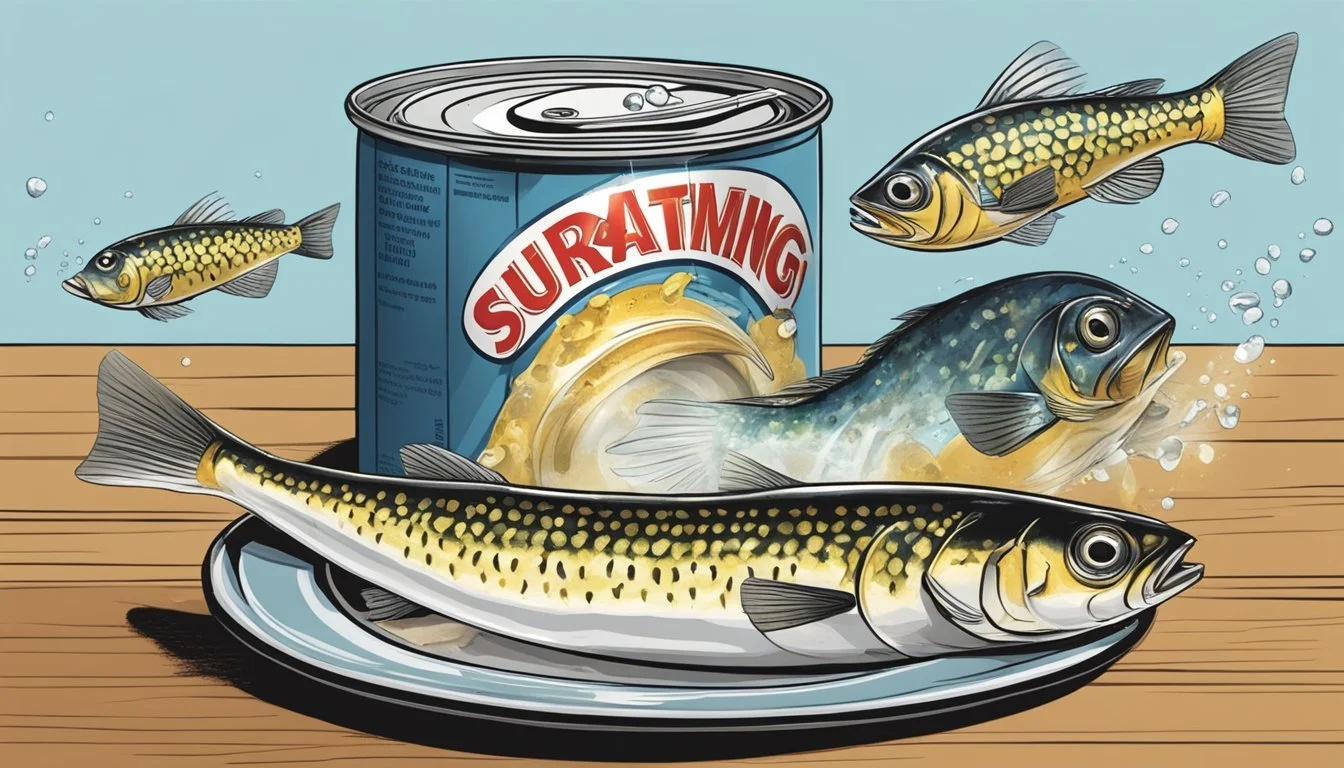Surströmming The Infamous Swedish Fermented Fish Challenge Unveiled
Surströmming is a traditional Swedish delicacy that has garnered international attention, often for its challenging nature to unaccustomed palates. This fermented fish dish boasts a remarkable cultural significance in Sweden, with roots stretching back to the 16th century. Originating during a period of salt scarcity, the process of fermenting the Baltic Sea herring allowed Swedes to preserve their catch without using much salt. Today, it is celebrated with surströmmingspremiären, the annual surströmming premiere, when the year's first cans are opened.
Acknowledged as an acquired taste, surströmming generates polarized reactions primarily due to its powerful aroma, which many liken to a pungent combination of rotten eggs and ammonia. The strong, distinctive odor stems from the fermentation process in which the herring is soaked in a mild brine solution for several months, producing the characteristic smell and flavor profile. It's commonly eaten with a Swedish flatbread called tunnbröd and is often paired with boiled potatoes, sour cream, and raw onions to balance the intense taste.
The surströmming challenge has become an internet phenomenon, prompting the curious and daring to experience this unique Swedish fermented fish. It's typically attempted in outdoor settings, to mitigate the fish's potent smell, and the ritual has become a testament to the enduring allure of one of Sweden's most notorious culinary exports. The challenge is not purely about endurance but also offers a glimpse into a culinary tradition that is a proud reflection of Sweden's history and its inventive approaches to food preservation.
The Origins and History of Surströmming
Surströmming, a fermented herring with a potent aroma, is deeply woven into Swedish tradition and history. It represents a historic delicacy that has stood the test of time, adapting to cultural and technological changes.
Traditional Roots in Swedish Cuisine
Surströmming, or "sour herring," is an essential part of Swedish cuisine, with its roots tracing back to at least the 16th century. Commonly found in the Baltic Sea, the smaller Baltic herring, known locally as strömming, is the primary component. The fermentation process utilized in surströmming is thought to have originated due to a salt shortage that made it necessary to use less salt than required for traditional preservation methods. This led to the herring fermenting rather than just being salted.
Development of Fermentation Techniques
Over time, the fermentation process has been refined to create the unique flavor profile of surströmming. Initially, the fish are gutted except for the kidneys, which leave an enzyme necessary for the fermentation. They are then placed in a strong saline solution to halt bacterial growth, allowing fermentation to occur from lactic acid bacteria present in the spine. The barrels are then kept in a controlled temperature, contributing to this delicacy's development. Before the advent of refrigeration technology, surströmming was an ingenious solution to preserving food through harsh winters. Moreover, a royal decree eventually allowed for the production of surströmming to be formalized and continued.
Culinary Aspects of Surströmming
Surströmming is a traditional Swedish dish known for its strong aroma and flavor, resulting from a fermentation process. This section focuses on the dish's ingredients and methods of preparation, as well as its conventional serving styles and typical accompaniments.
Ingredients and Preparation
The primary ingredient in surströmming is herring sourced from the Baltic Sea. These small fish are caught in spring when they are at their fattest and are then fermented. To begin the fermentation process, the herring are first salted to prevent them from rotting. They are then left to ferment in a controlled environment. This fermentation period can last for up to six months and develops the characteristic strong smell and taste of the dish.
The fermentation process is carefully monitored to ensure safety and desired flavor development. Once properly fermented, the surströmming is canned, where the fermentation continues until the cans are opened.
Serving Traditions and Accompaniments
Surströmming is typically eaten with a variety of accompaniments that help to balance its potent flavor. A common practice when serving the dish is to open the cans outdoors due to the strong odor, which can be overwhelming in enclosed spaces.
Common accompaniments include:
Tunnbröd: A type of soft or crispy Swedish flatbread.
Butter: Spread on the flatbread to add a layer of fat that mellows the fish's strong taste.
Boiled potatoes: Often served cold and sliced, offering a neutral taste contrast.
Sour cream: Adds a creamy texture and a tangy note to the dish.
Dill: A herb used both for flavor and garnish, enhancing the overall taste profile.
Chopped onion: Provides a crunchy texture and a pungent sharpness that complements the fish.
When participating in the surströmming challenge, a popular phenomenon where people dare to try the dish, these accompaniments can help make the pungent fish more palatable. It is common to compile these ingredients into a sandwich called surströmmingsklämma, with the herring at the center of the ensemble.
Chemistry and Biology of Fermentation
When assessing the complexities of surströmming, the fermenting process is driven by the action of bacteria on the fish, producing lactic acid as a byproduct, which significantly alters the physical and flavor properties of the fish.
The Role of Bacteria and Lactic Acid
Bacteria are fundamental to the fermentation of surströmming. Specifically, Lactiplantibacillus plantarum and Pediococcus acidilactici are two types of bacteria involved in the fermentation process. These beneficial microorganisms thrive in a brine solution—a saltwater mixture critical to the fermenting environment.
Salt in the brine acts as an inhibitor for unsuitable bacteria and pathogens, while providing an optimal environment for fermentation-friendly bacteria.
Lactic acid bacteria (LAB) then convert sugars present in the fish into lactic acid. This acidification process is facilitated by lactic acid enzyme activity.
Canning surströmming allows the fermentation process to continue, with the pH of the product lowering over time due to increasing lactic acid concentration. The pH typically ranges from approximately 6.67 to 6.98, indicating the environment is not highly acidic but sufficiently so to preserve the fish and impart the distinctive sour flavor.
Surströmming's unique taste and texture are owed to the fermenting process, which is both a chemical and biological symphony, resulting in a product that challenges many palates yet holds a special place in Swedish culinary tradition.
Sensory Experience and Public Perception
Surströmming presents a polarizing challenge to the senses, particularly due to its distinctive odor and flavor that leave a memorable impression.
The Infamous Smell and Taste Profiles
Smell: Surströmming releases potent gases when opened, often likened to rotten eggs and ammonia. Its strong smell earns it a reputation as one of the smelliest foods globally, featured even at the Disgusting Food Museum. The experience often evokes intense reactions due to the pungent nature of the fermented herring.
Taste: The taste profile of surströmming is an acquired taste, characterized by a salty-sourness and an umami flavor that can be appreciated by some after overcoming the initial overwhelming smell. Typically, the fish is consumed during a surströmmingsskiva, a traditional Swedish gathering, where the proper serving method can mitigate some of the sensory shock and enhance the eating experience.
Surströmming in Modern Culture
A traditional dish with a pervasive aroma, surströmming has become an intriguing aspect of Swedish culture, not only for its distinctive flavor but also for the social events and global curiosity it inspires.
Surströmming Events and Festivals
Surströmmingsskiva, or surströmming parties, are traditional gatherings in Sweden where the fermented herring is a central component. These typically occur from the third Thursday of August, known as surströmmingspremiär, marking the beginning of the season that runs through September. Participants often consume surströmming as part of a surströmmingsklämma, a sandwich made with buttered tunnbröd (flatbread), boiled potatoes, and sometimes onions and sour cream.
The High Coast area in Sweden is renowned for its deep ties with surströmming culture, with festivals that attract enthusiasts eager to brave the notorious culinary challenge. The surströmming challenge has grown from its regional roots to gain international attention, inviting the brave to sample a dish famed for its challenging scent and acquired taste.
Media Coverage and Challenges
Surströmming has piqued global interest, often showcased in media segments highlighting "the world's smelliest food." Food enthusiasts and influencers from around the world have taken on the surströmming challenge, recording their reactions to the potent aroma and taste of the fermented fish for audiences on various social media platforms. This curiosity has solidified surströmming's reputation and has become a source of fascination and entertainment, underpinning its unique place in modern culture.
Health and Nutrition Considerations
When discussing the health and nutritional aspects of surströmming, it is important to consider the core components of this traditional dish. It is a source of protein and vitamins essential to a balanced diet.
Nutritional Value and Dietary Information
Surströmming, as a fermented form of herring, retains the nutritional benefits associated with fish. Herring is known to be a good source of protein, which is crucial for building and repairing tissues in the body.
Protein Content: Fish such as herring is typically rich in complete protein, containing all of the essential amino acids needed in the human diet.
In addition to protein, vitamins are present in surströmming, contributing to its nutritional profile. These include:
Vitamin B12: Essential for brain health and the creation of DNA.
Vitamin D: Important for bone health and immune function.
Surströmming, being a fermented fish, might have different gut health implications compared to regular fish due to the presence of live bacteria from the fermentation process. Fermented foods (What wine goes well with fermented foods?) can contribute to a healthy gut microbiome, although direct effects from surströmming consumption would require further research specific to this food.
It is key to mention that while surströmming can contribute to a varied diet, its strong flavor and odor might not be palatable to everyone, potentially influencing its role in one's eating habits.
Comparative Analysis with Other Fermented Foods
In exploring the realm of fermented delicacies, Surströmming stands out for its intense aroma and traditional roots. However, a multitude of cultures harbour their own versions of fermented specialties, each with unique characteristics.
Global Fermented Fish Delicacies
Globally, several fish fermentation techniques exist, creating dishes that vary in taste, texture, and odor intensity. For instance, Hákarl from Iceland is made from Greenland shark, which is fermented and cured for several months, acquiring a potent ammonia-rich smell and a strong fishy taste. Meanwhile, in Korean cuisine, Hongeo-hoe is a dish of fermented skate known for its ammonia-like odor due to the high concentration of urea.
Lutefisk, originating from Nordic countries, is dried whitefish rehydrated in lye, creating a gelatinous texture and relatively mild smell compared to Surströmming. Fermented Baltic herring, the key ingredient of Surströmming, undergoes a fermentation process for at least six months. Its pungency is infamous, making it a contender for the world's smelliest food.
Similar Practices in Different Cultures
Cultural parallels can be seen in how various societies approach the practice of fish fermentation. In Japan, Nattō is a staple made from fermented soybeans with Bacillus subtilis, offering a strong smell and sticky texture quite dissimilar to fermented fish yet sharing the theme of fermentation for enhanced flavor and preservation. Fermented Baltic Sea herring, used in Surströmming, demonstrates the Scandinavian tradition of preserving fish, with practices dating back centuries.
The Mediterranean region offers Casu marzu, a Sardinian cheese notable for the fermentation process that involves live insect larvae. Despite its relation to Surströmming in terms of controversial appeal and fermentation, the foundations of its creation and the taste profiles are remarkably different.
Each culture's fermented food reflects their unique heritage and gastronomic ingenuity, with Surströmming firmly placed in Sweden's traditional culinary practices.
Legal and Environmental Aspects
When discussing Surströmming, it is important to consider not only its unique cultural place but also the legal frameworks and environmental factors tied to its production. These aspects are crucial for maintaining the balance between tradition and sustainability.
Fishing Regulations and Sustainability
Baltic Sea herring, the key ingredient in Surströmming, falls under strict fishing regulations designed to preserve fish stocks and marine ecosystems. The Swedish government enforces quotas and seasonal restrictions to ensure the sustainability of herring catches from the Baltic Sea. This is critical because the Baltic herring plays a significant role in the region's biodiversity and commercial fishing industry. By adhering to these regulations, producers of Surströmming help to minimize environmental concerns associated with overfishing.
Production and Export Laws
When it comes to production, Surströmming must comply with Swedish food safety laws to ensure public health. Fermentation is a delicate process, and producers are required to maintain specific hygiene standards. As for exports, countries have varying regulations regarding the import of Surströmming due to its strong odor. Some airlines have even banned the transport of these cans, considering them potentially hazardous goods. Thus, producers and consumers alike must navigate a complex web of laws when distributing and purchasing Surströmming outside of Sweden.
Consumer Insights and Purchasing Tips
When purchasing surströmming, it’s essential for consumers to understand where to find this unique Swedish delicacy and what to consider regarding quality and longevity.
Where to Buy and Price Considerations
Surströmming can primarily be found in Sweden, but it is also available through international online vendors specializing in Swedish foods. The price fluctuates depending on the brand, size of the can, and point of sale. Generally, consumers can expect to pay anywhere from 15 to 60 USD for a can.
Swedish Dish Suppliers: Trusted local and online suppliers of traditional Swedish foods.
Surströmming Museum: A specialty venue that may offer sales of surströmming and insights into its production.
Online Retailers: E-commerce platforms carry surströmming cans ready for global shipment.
Quality Indicators and Shelf Life
The quality of surströmming is primarily determined by its fermentation process and storage conditions. Fresh cans will often have a slightly bulged appearance, indicating proper fermentation gas build-up. Before purchasing, individuals should check for:
Sell-by Date: Ensure the can is within its consumption period for optimal taste.
Can Integrity: No rust or damage, as it can affect the fermentation inside.
Cans of surströmming have a long shelf life when kept unopened and stored at a cool temperature, away from direct sunlight. Once opened, it should be consumed within a few days to experience its robust flavor profile, which makes it a celebrated Swedish delicacy among food lovers.






